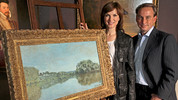News:
The Wildenstein era will end, and the art market will benefit
By Tom Flynn

At last the BBC has made decent programme about the art market. However, the conclusions reached on 'Fake or Fortune' confirm what most of us already knew — that when exposed to a raking light, the art market is a deeply unpleasant place in which to do business.
The programme — still available on the BBC's iPlayer (here ) had presenter Fiona Bruce and renowned London-based art sleuth Philip Mould (above left) seeking to authenticate a Monet — Les bords de la Seine à Argentueil — bought for £40,000 some 18 years ago by David Joel, a British man in his eighties. Mr Joel has never been in any doubt that his painting was a signature work by Monet. Trouble is, the mighty Wildensteins disagree.
) had presenter Fiona Bruce and renowned London-based art sleuth Philip Mould (above left) seeking to authenticate a Monet — Les bords de la Seine à Argentueil — bought for £40,000 some 18 years ago by David Joel, a British man in his eighties. Mr Joel has never been in any doubt that his painting was a signature work by Monet. Trouble is, the mighty Wildensteins disagree.
For forty years the Wildenstein dynasty in Paris has been publishing the five-volume Monet catalogue raisonné, the 'bible' containing all known authenticated works by the artist. No Monet can be sold at a major auction house without being listed in the catalogue.
The problem is that the catalogue is based solely on the opinion of the Wildensteins and, as the programme conclusively demonstrated, that opinion is no longer reliable or trustworthy.
Daniel Wildenstein, who died in 2001, first published the Monet catalogue in 1974. On his death, Daniel's son Guy Wildenstein inherited the privilege of being the sole arbiter of authenticity where Monets are concerned. But as this programme revealed, the house of Wildenstein is the art world equivalent of the Augean stables. It's high time the international art market re-routed the rivers of authentication to bypass the Wildenstein mafia and their vested interests.
In the programme, Bruce and Mould ventured on a long and exhaustive quest that embraced cutting-edge technological analysis into the painting's physical structure, deep archival research into the picture's provenance, and all-embracing consultation with the world's leading Monet scholars.
The result was as close to a cast-iron, bullet-proof, water-tight attribution to Monet as one could ever hope to get. Yet still it was not enough to convince the Wildensteins who would not even deign to meet Mould and Bruce. Instead they demanded that the painting and the dossier of evidence be left at their fortress-like headquarters in Paris where they would look at it in their own good time.
A few days later, the Wildenstein committee finally pronounced — "No," was their patrician verdict on the picture's authenticity — thereby confirming how hopelessly compromised the Wildenstein edifice has become.
For the past 18 years, the late Daniel Wildenstein has consistently rejected David Joel's painting, although at no point during that time had the painting been treated to the deep forensic analysis brought to bear on it today. Thus, when presented with the compelling evidence of its authenticity, Daniel's son Guy was stuck between a rock and hard place. 
To accept the painting as an authentic work would have been tantamount to undermining his father's fabled authority. This may explain why he and his committee failed properly to inspect the dossier of evidence, instead rejecting it out of hand. By doing so, he has exposed the Wildenstein authentication process as a creaking edifice teetering on the point of collapse. What we are hearing is the death knell of an art market era once dominated by George Wildenstein (right) whose opinion on a work of art was the word of God. But absolute power corrupts absolutely, or, as the saying goes, a fish rots from the head.
The Wildenstein family is currently under investigation for alleged "concealment of theft" of millions of pounds worth of paintings entrusted to Daniel Wildenstein by Anne-Marie Rouart, a descendant of Manet. A further allegation of "theft and concealment" has been made by the heirs of Joseph Reinach who had many works stolen by the Nazis. Meanwhile, The Daily Telegraph reports that the Wildenstein family faces allegations of having failed to declare the true extent of their estate for tax purposes.
reports that the Wildenstein family faces allegations of having failed to declare the true extent of their estate for tax purposes.
The Wildensteins may have momentarily obstructed the progress of David Joel's Monet landscape, but it is only a matter of time before they and their ilk are swept aside by the forces of technology. Digital databases are already making provenance research more open and accessible. High-resolution Lumière cameras (240 million pixels), plus infra-red, ultra-violet and multi-spectral scanning, are steadily providing means of authenticating works of art that could undermine the exclusive privilege traditionally enjoyed by the connoisseur's eye. What is needed now is for the broader art market to build an ethical consensus and topple the Wildensteins from their lofty perch.
(240 million pixels), plus infra-red, ultra-violet and multi-spectral scanning, are steadily providing means of authenticating works of art that could undermine the exclusive privilege traditionally enjoyed by the connoisseur's eye. What is needed now is for the broader art market to build an ethical consensus and topple the Wildensteins from their lofty perch.
The Wildenstein era is almost over. Amen to that.
http://tom-flynn.blogspot.com/2011/06/wildenstein-era-will-crumble-and-art.html


